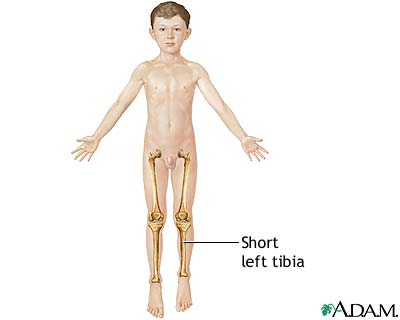Leg lengthening - series
Indications

The most common bones treated with lengthening procedures are the bones of the leg, the tibia and the femur.
Surgical treatment may be recommended for severe unequal leg lengths caused by:
- poliomyelitis and cerebral palsy
- small, weak (atrophied) muscles or short, tight (spastic) muscles may cause deformities and prevent normal leg growth
- hip diseases such as Legg-Perthes disease
- previous injuries or bone fractures that may stimulate excessive bone growth
- abnormal spinal curvatures (scoliosis)
- birth defects (congenital deformities) of bones, joints, muscles, tendons, or ligaments
Update Date: 11/12/2010
Updated by: Neil K. Kaneshiro, MD, MHA, Clinical Assistant Professor of Pediatrics, University of Washington School of Medicine. Also reviewed by David Zieve, MD, MHA, Medical Director, A.D.A.M., Inc.
Related Page
Notice: The information provided herein should not be used during any medical emergency or for the diagnosis or treatment of any medical condition. A licensed physician should be consulted for diagnosis and treatment of any and all medical conditions. Call 911 for all medical emergencies. Links to other sites are provided for information only -- they do not constitute endorsements of those other sites. Copyright 1997-2012, A.D.A.M., Inc. Any duplication or distribution of the information contained herein is strictly prohibited.
